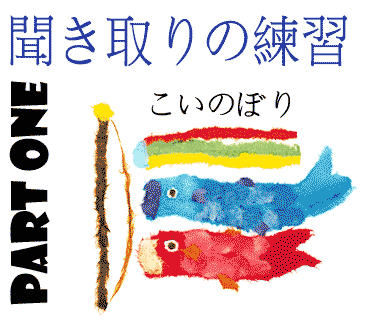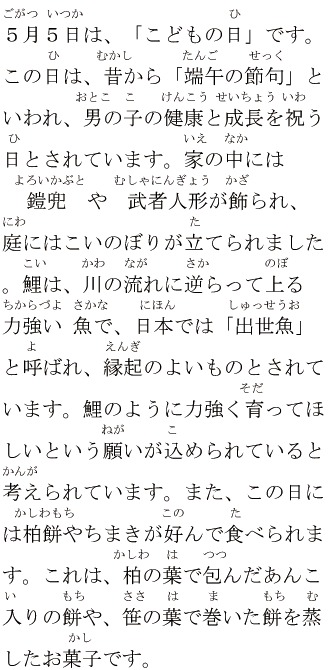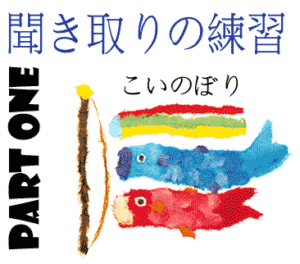
Koinobori are the Carp Flags flown on Children’s Day in honor of boys.
Read the story below while listening to the audio either fast (normal speed) or slow if you need to train your ears.
Download or view the PDF for more explanation.
Slow Speed
NORMAL Speed

5月5日gogatsu itsuka May 5th
こどもの日kodomo no hi Children’s day
この日は kono hi wa as for that day
昔から mukashi kara from a long time
端午の節句 tango no sekku another name
for May 5th
といわれ to iware is called
男の子 otoko no ko boy
健康 kenkou health
成長 seichou growth
祝う日 iwau hi day to celebrate
家の中 ie no naka inside a house
鎧兜 yoroikabuto samurai armor/helment
武者人形 musha ningyou warrior doll
飾られ kazarare displayed
庭 niwa garden
鯉のぼり koinobori Carp kite/flag
立てられました tateraremashita is stood
up, erected
鯉 koi Koi fish, carp
川の流れに kawa no nagare ni flow of river
逆らって上る sakaratte noboru climb
against (flow of water)
力強い魚 chikara zuyoi sakana strong fish
日本 nihon Japan
出世魚 shusse uo successful fish [shusse means to succeed, advance in life] と呼ばれ to yobare is called
縁起のよいもの engi no yoi mono lucky
育ってほしい sodatte hoshii want to be raised
という願いが込められている to iu negai ga komerareteiru make such a wish
と考えられています to kangaerareteimasu it is thought…
また mata also
柏餅 kashiwa mochi Mochi (rice cake)
wrapped in oak leaf
ちまき chimaki Mochi wrapped in bamboo
leaves
好んで kononde liked, to be fond of
食べられます taberaremasu is eaten
柏の葉 kashiwa no ha oak leaf
あんこ anko bean jam/paste
入り iri added (anko)
もち mochi Mochi, rice cake
Translation Notes
- こどもの日 was once just for boys (hence the 鯉のぼり) but to be fair to the
girls, it was changed to こともの日. There is still a day specifically for girls on
March Third (3-3, also called 桃の節句 momo no sekku) called ひな祭り
(doll festival) - 端午の節句 is May fifth (5-5) while the girls’ 桃の節句 is March third (3-3)
- とされています or といわれ and similar passive phrases are often used to
explain cultural traditions. This is similar to the English “they said…” - Notice the trailing い in 力強い which tells us the reading will be the 訓読み.
The つよい adds a ten-ten to become ちからづよい - 縁起のよいもの (or 縁起がよい)is a set phrase meaning “lucky” and usually
deals with being superstitious; 縁起の悪いもの would be the opposite.
縁起をかつぐ is “to be superstitious” - 願いを込める is a set phrase/idiom meaning “to make a wish”. The fulfillment
of a wish is 願いがかなう “dreams come true” - Chchan45 from the Forums mentioned this important point: Also、learners of
Japanese should be informed that the following kanji are not in commonly used (i.e.
they are outside 常用漢字).鯉(こい)
餅(もち)
鎧兜(よろいかぶと)
柏(かしわ)
粽(ちまき)





